Michael Prodanou’s abstract figures are composed slowly but energetically. First, he considers a nude, making sketches and drawings in charcoal. Later, painting from these sketches, Prodanou moves fast, applying oil paint and black oil stick for his bold, gestural contours. He also paints big — one of his paintings, Kinesis, stretches over 13 feet across the wall of his studio — though the paintings at his upcoming exhibition in Wellfleet will be more modest in size.

“The planes and the bodies — I had to rip them apart but still make one kind of composition,” he says, standing on a platform in his studio.
Lovers and nudes emerge from the finished abstractions. In Thermi (Fervor), for example, the black oil stick defines the shape of an embrace, two lovers wrapped around each other, not lazily but standing bent and muscular, as if carrying one another through space. The contours give recognition to the figure, while color is used abstractly: deep forest greens suggest nighttime shadows; a torso comes to the fore in cool yellow. And is that a stroke of ripe peach on an ass cheek, a little rose for heat on the loved one’s lats?
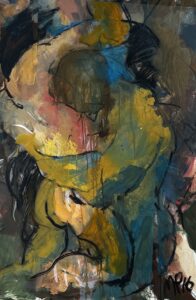
“I’m trying to get rhythm and movement,” he says, but he doesn’t want to lose the legibility of the figures in the process.
Artist and curator Robert Rindler has selected 10 of Prodanou’s paintings for “Figures,” a show at the Wellfleet Adult Community Center opening Sunday, Aug. 4 and on view there through the end of the month.
New paintings by Sean Flood also emerge from drawings and from the pursuit of rhythm. His large-scale abstract paintings are on view at Schoolhouse Gallery until Aug. 6.
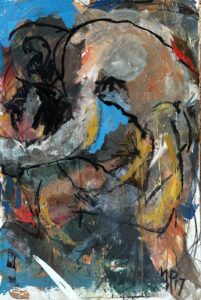
Like Prodanou, Flood sets down gestures and movement in confident strokes. But where Prodanou’s marks are sweeping and thick, Flood’s are intricate and fine. Color applied selectively taps memories that feel specific, impressionistically serving legibility in his works. Many of Flood’s works pursue sound and music, which the painter says is his primary inspiration.
For Adess Rehearsal 1-5, an etching, Flood observed rehearsals of the Boston Symphony Orchestra and etched dry point on site from life. The sound and rhythm of the scene extended beyond the score for him: he kept drawing while the orchestra went on breaks, seeing that when the music stopped some musicians left in a hurry while others stayed and went into their own rhythms. He was drawn to the chaos. “It was a dizzying melody of random sound,” he says.
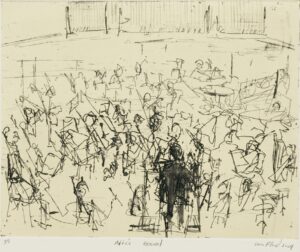
Later, back in his studio, Flood painted Cacophony, which captures the “in-motion feel” of the rehearsals. The painting employs the same looseness and freedom of gesture and movement as the etching, but now it is rendered in oil paint.
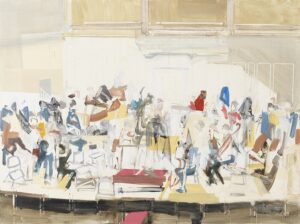
Flood grew up in Plymouth and now lives 10 miles inland in Plympton, “tucked into a tiny little town in the woods” where he says he has to drive two minutes down the road to get cell service. He is nonetheless drawn to the commotion of those orchestra rehearsals and to the ever-changing noises of cities. He spent his college years in Boston, where he got a B.F.A. from the Art Institute of Boston in 2005. He still visits there and travels to New York City frequently, “trying to find different subjects to play with,” he says. He bikes the cities in summer and rides the trains in winter, then brings his drawings back to the woods to paint.
Images in Flood’s paintings are layered over one another, an effect he achieves by mixing a flat alkyd glaze with oil paint for different degrees of transparency. “It works well with what you see in the subway since everything is constantly overlapping,” he says. “My application of the paint tries to work with the sound of the subway.” The glaze makes the paint dry fast, the better to allow him to work over the painting again quickly.
In Flood’s seven-foot-long MTA, which he calls a “portrait” of Boston’s subway system, we see the back of a train car moving away from us. Figures seem to move about in the car, some seated and some holding onto the interior bars. “I was trying to take all the elements and bits and pieces from each work and put them together here,” he says.
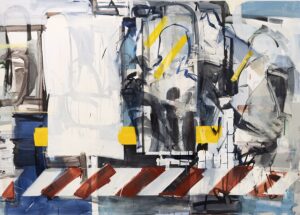
Where Flood draws from rhythms that reverberate from our human-made world, Prodanou contemplates the body. He’s an admirer of the work of Egon Schiele, who at the turn of the last century scandalized and tantalized viewers with his decadent, sometimes tormented early Expressionist nudes.
“I want to show emotion, action, some kind of passion,” Prodanou says. Moving around his brightly lit second-floor studio, he tosses some of his sketches onto the floor and throws a sharp look at a row of paintings. “I’m not happy with some of them,” he says.
Prodanou was born in Toronto and graduated from the University of Toronto with a degree in architecture in 1959. But he writes in his artist’s statement online: “I always loved to draw.” He started drawing and painting in earnest in 2000, a year after he sold his architecture practice.
Prodanou shares his workspace off Race Point Road in Provincetown with his husband, the photographer Constantine Manos. Though both Prodanou and Manos spent time in Greece, separately exploring their immigrant families’ homeland, the two met in New York City. They locked eyes in a restaurant mirror in 1963. Prodanou was working at the Architects Collaborative with Walter Gropius at the time, and he and Manos moved their center of gravity to Cambridge.
That this generation-crossing pair of exhibitions of large-scale works overlap in time during the days ahead is a not-to-be-missed invitation to contemporary abstract painting. Moving back and forth between the two collections makes for a tour of movement and sound, and, perhaps unexpectedly, whether one is viewing bodies or the manmade spaces they inhabit, it is one full of passion.
Rhythm and Movement
The event: Michael Prodanou’s paintings, curated by Robert Rindler
The time: On view through August; opening reception Sunday, Aug. 4, 3-5 p.m.
The place: Wellfleet Adult Community Center, 715 Old King’s Highway
The cost: Free
Dizzying Melodies
The event: New works by Sean Flood
The time: On view through Aug. 6
The place: Schoolhouse Gallery, 494 Commercial St., Provincetown
The cost: Free
